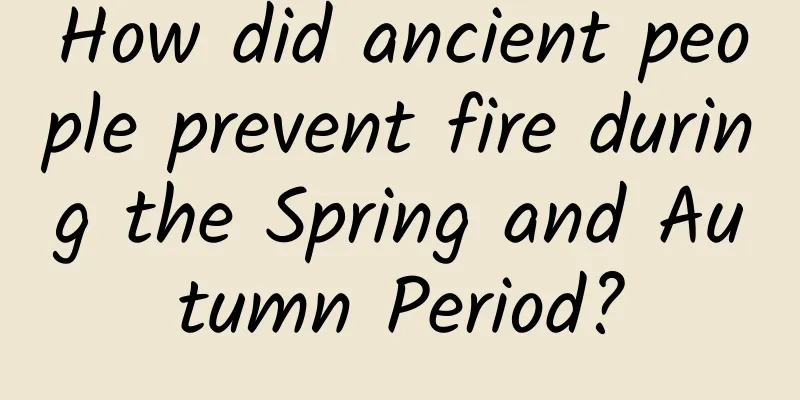How did ancient people prevent fire during the Spring and Autumn Period?

|
The Spring and Autumn Period usually refers to the historical period from 770 BC to 476 BC in the first half of the Eastern Zhou Dynasty in China. China's fires during the Spring and Autumn Period, as well as people's fire-fighting ideas and methods, were mainly recorded in two pre-Qin classics. One is the Spring and Autumn Annals. It is said that the historian of the State of Lu recorded the major events of various countries at that time by year, season, month and day, and divided the year into four seasons: spring, summer, autumn and winter, and named this chronicle the Spring and Autumn Annals. The other is Zuo Zhuan, which is said to be written by Zuo Qiuming. It is a complete chronological history book in ancient China and a representative of pre-Qin prose works. "Spring and Autumn Annals" and "Zuo Zhuan" recorded 23 fires and formed a system, leaving a valuable legacy for future generations to study the fires and firefighting at that time. In the Spring and Autumn Period, the highest executive officers of various countries paid special attention to firefighting. Under the historical conditions at that time, the countries were relatively small, and the heads of state, military and wealth were concentrated in the capital. Once a major fire occurred in the capital, not only would the losses be heavy, but the neighboring powerful countries would take advantage of the situation and invade, which would be a matter of national survival. Attaching importance to fire protection is first and foremost reflected in doing a good job of fire prevention. For example, the State of Song demolished flammable huts in its capital and used mud to seal the combustible components of large houses that were not suitable for demolition to improve their flame retardant properties. The relevant parties also stockpiled water for firefighting, piled up sand and soil, and prepared ropes and water containers for drawing water from wells. The Song Dynasty also required all departments to be prepared for emergencies and disaster relief at any time. Each country has clear ideas on what objects must be protected once a fire occurs. Classical documents In the third year of Duke Ai of Lu, a fire broke out in the Sijiao Palace, burning down the temples of Duke Heng and Duke Xi. At this time, the firefighters said they would first protect the warehouses in the palace where supplies were stored. Nangong Jing arrived just in time and ordered the officials in charge of Zhou books to move the "Imperial Book" out first and guard it there, otherwise they would be executed. The Song State's fire-fighting measures also ordered the Grand Chancellor to manage the "Six Classics" and the Sikou to manage the criminal code. This shows that when the fire broke out, rescuing the classics and documents related to governing the country took priority over general supplies. The palace where the monarch lived During the fire that broke out in the third year of Duke Ai of Lu, everyone tried every means to protect Duke Ai's palace. The main shrine and the big turtle When a fire broke out in Zheng State, the chief officer in charge of firefighting ordered Zhushi to move the former king's Zhuhu to Zhou Temple for centralized protection, and sent Gongsun Deng to move the giant tortoise used for divination. During the Spring and Autumn Period, buildings were not very large and were mostly made of combustible components such as hay and wood. Once a fire broke out, it was difficult to extinguish. The main goal of rescue is to prevent the fire from spreading to adjacent buildings and prevent the disaster from expanding. There are two main methods used. One is to open a fire barrier, that is, to open a separation zone between the building on fire and the building to be protected, and remove the combustibles between the separation zone, including some small buildings. The other is the "Ji Ru Curtain", which is a fabric such as curtains soaked in water and used to cover the building to protect it from fire. During the fire rescue in the third year of Duke Ai of Lu, both methods were used to protect the palace. The people-oriented idea was also reflected in fire rescue in the Spring and Autumn Period. When fighting a fire in the third year of Duke Ai of Lu, Ji Hengzi issued an order: "Firefighters should stop fighting if they injure people, and they can save money." That is, if firefighters are injured or face danger, they should stop fighting the fire. Because property can be recreated after it is burned, but the damage to people cannot be repaired. More than two thousand years have passed, and the wisdom of the ancients is admirable, and their fire rescue methods are still worth learning from. END Text | Fan Qiangqiang Picture | From Baidu Pictures Mr. Fire |
<<: China Chenghuang Temple viewing guide! Who is silently guarding your hometown?
Recommend
China Association of Automobile Manufacturers: Economic Operation of the Automobile Industry in October 2021
According to statistics and analysis by the China...
If you encounter these situations during the Spring Festival, it is recommended to call the police immediately! ! !
One minute with the doctor, the postures are cons...
3 types of product value make users more willing to buy your product
Many people may think: What value can a product r...
Development of e-commerce live streaming mini program, how can e-commerce mini program have strong competitiveness?
There are many ways for e-commerce to exist, but ...
Teach you step by step the effective methods to improve your marketing and copywriting skills
As marketers , we generally have a good habit of ...
Breaking the theoretical limit again! Scientists detect the second most energetic cosmic ray ever
On November 24, 2023, in a study published in the...
Five things you should pay attention to when getting App Store editorial recommendations
Appstore is a must-go place for IOS system users ...
What is Baidu paid search remarketing? What is the difference with search promotion?
What is Baidu bidding search remarketing? What ar...
Suspending car sales, subsidies for 2017 decline, new energy vehicle companies collectively wait and see
New energy vehicle companies are considering whet...
Why is the upcoming Year of the Tiger only 355 days?
The upcoming Lunar Year of the Tiger From Februar...
It can "breathe fire"! Be careful when buying it
Can you buy a hair dryer for 15 yuan? Is it safe?...
What's so strange about hanging a person? Your hair is much stronger than an elephant's hair.
Key Points ★ Theoretically, a head of hair is eno...
Man's Samsung phone overheated and became scrapped: He was forced to sign a nondisclosure agreement during after-sales service
Samsung's new flagship Galaxy S8 is scheduled ...
Can drinking yogurt protect against computer radiation? Don’t exaggerate the claim…
Ruan Guangfeng Yogurt tastes sweet and sour and i...
Fantastic mammatus clouds appear in the sky, people with claustrophobia should beware
Two days ago, a cloud appeared in the lead-gray s...









